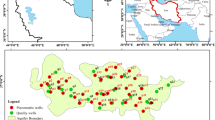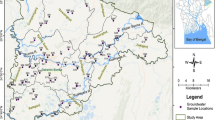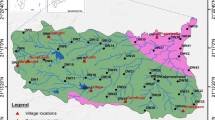Abstract
A discrete entropy-based approach is used to assess the groundwater monitoring network that exists in Kodaganar River basin of Southern India. Since any monitoring system is essentially an information collection system, its technical design and evaluation require a quantifiable measure of information and this measure can be derived using entropy. The use of information-based measures of groundwater table shows that the existing monitoring network contains a sufficient number of wells but is not well designed for the measurement of groundwater level. Entropy-based results show that 15 wells are vital to measure regional groundwater level, not 28 wells which are being monitored effectively in this basin.








Similar content being viewed by others
References
Balasubramanian K (1980) Geology of parts of Vedasandur Taluk, Madurai District, Tamil Nadu. Progress Report for the Field Season 1979–80. GSI Tech Report, Madras, p 14
Carranza ML, Acosta A, Ricotta C (2007) Analyzing landscape diversity in time: the use of Rènyi’s generalized entropy function. Ecol Indic 7:505–510
Caselton WF, Husain T (1980) Hydrologic network: information transmission. J Water Resour Plan Manag Div ASCE 106(WR2):503–529
Chakrapani R, Manickyan PM (1988) Groundwater resources and developmental potential of Anna District, Tamil Nadu State. CGWB Report, Southern Region, Hyderabad, p 49
Darbellay GA, Wuertz D (2000) The entropy as a tool for analyzing statistical dependence in financial time series. Phys A 287(3–4):429–439
Ground Water Resource Estimation Committee (GWREC) (1996) Ground Water Resource Estimation Methodology-1996. Ministry of Water Resources (Government of India) Report, New Delhi
Gull SF (1991) Some misconceptions about entropy. In: Buck B, Macauley VA (eds) Maximum entropy in action. Oxford University Press, Oxford
Harmancioglu NB (1981) Measuring the information content of hydrological processes by the entropy concept. Journal of Civil Engineering, Faculty of Engineering, Special Issue for the Centennial of Ataturk’s Birth, Ege University, Izmir, Turkey, pp 13–38
Harmancioglu NB, Alpaslan N (1992) Water quality monitoring network design: a problem of multiobjective decision making. Water Resour Bull 28(1):179–192
Harmancioglu NB, Fistikoglu O, Ozkul SD, Singh VP, Alpaslan MN (1999) Water quality monitoring network design. Kluwer Academic Publishers, Boston, p 299
Harmancioglu NB, Yevjevich V (1987) Transfer of hydrologic information among river points. J Hydrol 91:103–118
Herrmann K (2009) Non-extensitivity vs. informative moments for financial models—a unifying framework and empirical results. Lett J Explor Front Phys 88(30007):1–5
Jessop A (1995) Informed assessments, an introduction to information, entropy and statistics. Ellis Horwood, New York, p 366
Karamanos K (2009) Characterizing Cantorian sets by entropy-like quantities. Kybernetes 38(6):1029–1036
Karamouz M, Khajehzadeh Nokhandan A, Kerachian R, Maksimovic C (2009) Design of on-line river water quality monitoring systems using the entropy theory: a case study. Environ Monit Assess 155:63–81
Khalil B, Ouarda TBMJ (2009) Statistical approaches used to assess and redesign surface water-quality-monitoring networks. J Environ Monit 11:1915–1929
Krastanovic PF, Singh VP (1992) Evaluation of rainfall networks using entropy II. Water Resour Manag 6:295–314
Krishnan MS (1982) Geology of India and Burma. CBS Publishers and Distributions, India
Lebowitz JL (1993) Boltzmann’s entropy and time’s arrow. Phys Today 46(9):33–38
Lubbe CA (1996) Information theory. Cambridge University Press, Cambridge, p 350
Masoumi F, Kerachian R (2008) Assessment of the groundwater salinity monitoring network of the Tehran region: application of the discrete entropy theory. Water Sci Technol 58(4):765–771
Medhi J (2005) Statistical methods—an introductory text. New Age International Publishers, New Delhi, p 438
Mogheir Y, De Lima JLMP, Singh VP (2003) Spatial structure assessment of groundwater quality variables based on the entropy theory. Hydrol Earth Syst Sci 7(5):707–721
Mogheir Y, De Lima JLMP, Singh VP (2004) Characterizing the spatial variability of groundwater quality using the entropy theory: I. synthetic data. Hydrol Process 18:2165–2179
Mogheir Y, De Lima JLMP, Singh VP (2005) Assessment of informativeness of groundwater monitoring in developing regions (Gaza Strip Case Study). J Water Resour Manag 19:737–757
Mogheir Y, Singh VP (2002) Application of information theory to groundwater quality monitoring networks. Water Resour Manag 16:37–49
Mondal NC, Saxena VK, Singh VS (2005) Assessment of groundwater pollution due to tanneries in and around Dindigul, Tamil Nadu, India. Environ Geol 48(2):149–157
Mondal NC, Singh VP (2010) Entropy-based approach for estimation of natural recharge in Kodaganar River basin, Tamil Nadu, India. Curr Sci 99(11):1560–1569
Mondal NC, Singh VP (2011a) Hydrochemical analysis of salinization for a tannery belt in Southern India. J Hydrol 405(2–3):235–247
Mondal NC, Singh VP (2011b) Chloride migration in groundwater for a tannery belt in Southern India. Environ Monit Assess. doi:10.1007/s10661-011-2156-x
Mondal NC, Singh VS (2004) A new approach to delineate the groundwater recharge zone in hard rock terrain. Curr Sci 87(5):658–662
Mondal NC, Thangarajan M, Singh VS (2002) Assessment of groundwater quality in Kodaganar river basin, Tamilnadu, India. In: Venkateswara Rao B, Ramamohan Reddy K, Sarala C, Raju K (eds) Proceedings of international conference on hydrology and watershed management, vol I. BS Publications, Hyderabad, pp 578–586
Nicolae A, Nicolae M, Predescu C, Sohaciu MG (2009) Theoretical analysis of the economy-ecology-environment system. Environ Eng Manag J 8(3):453–456
Ozkul S, Harmancioglu NB, Singh VP (2000) Entropy-based assessment of water quality monitoring networks. J Hydrol Eng 5(1):90–100
Public Works Department (2000) Groundwater perspectives: a profile of Dindigul District, Tamil Nadu. PWD Report, Government of India, Chennai, p 78
Public Works Department (2008) Public Works Department Irrigation Policy Note for the year 2008–2009. Govt. of India, Chennai, p 51
Ricotta C, Corona P, Marchetti M (2003) Beware of contagion!. Landsc Urban Plan 62:173–177
Rojdestvenski I, Cottam MG (2000) Mapping of statistical physics to information theory with application to biological system. J Theor Biol 202(1):43–54
Sato AH (2008) Application of spectral methods for high-frequency financial data to quantifying states of market participants. Phys A 387(15):3960–3966
Shannon CE (1948) A mathematical theory of communications, I and II. Bell Syst Tech J 27:379–443
Singh VP (1998) Entropy-based parameter estimation in hydrology. Kluwer Academic Publishers, Boston
Singh VP (2010) Entropy theory for derivation of infiltration equations. Water Resour Res 46:1–20, W03527. doi:10.1029/2009WR008193
Singh VS, Mondal NC, Barker R, Thangarajan M, Rao TV, Subramaniyam K (2003) Assessment of groundwater regime in Kodaganar river basin (Dindigul district), Tamil Nadu. Tech. Report No. NGRI-2003-GW-269, p 104
Siradeghyan Y, Zakarian A, Mohanty P (2008) Entropy-based associative classification algorithm for mining manufacturing data. Int J Comput Integr Manuf 21(7):825–838
Surfer Version 8.00 (2002) Surface Mapping System Copyright@1993–2002, Golden Software, Inc. http://www.goldensoftware.com
Sy BK (2001) Information–statistical pattern based approach for data mining. J Stat Comput Simul 69(2):171–201
Thangarajan M, Singh VS (1998) Estimation of parameters of an extensive aquifer—a case study. J Geol Soc India 52:477–481
Tirsch FS, Male JW (1984) River basin water quality monitoring network design. In: Schad TM (ed) Proceedings of 20th annual conference of American water resources association. Options for reaching water quality goals, AWRA Publications, pp 149–156
Todd DK (1980) Groundwater hydrology, 2nd edn. Wiley, New York, p 535
Uslu O, Tanriover A (1979) Measuring the information content of hydrological process. In: Proceedings of the first national congress on hydrology, Istanbul, pp 437–443
Wehri A (1978) General properties of entropy. Rev Mod Phys 50(2):221–260
Woldt W, Bogardi I (1992) Ground water monitoring network design using multiple criteria decision making and geostatistics. Water Resour Bull 28(1):45–62
Yang Y, Burn D (1994) An entropy approach to data collection network design. J Hydrol 157:307–324
Zhou P, Fan L, Zhou D (2010) Data aggregation in constructing composite indicators: a perspective of information loss. Expert Syst Appl 37:360–365
Acknowledgments
The first author had performed this work, in part, under the BOYSCAST Fellowship funded by Department of Science and Technology (Government of India), New Delhi (Ref. No. SR/BY/A-05/2008, Date: 16–19 January 2009). The officials of PWD, Chennai provide the suitable data. The four anonymous reviewers had suggested their constructive comments to improve this article. The authors are thankful to them.
Author information
Authors and Affiliations
Corresponding author
Rights and permissions
About this article
Cite this article
Mondal, N.C., Singh, V.P. Evaluation of groundwater monitoring network of Kodaganar River basin from Southern India using entropy. Environ Earth Sci 66, 1183–1193 (2012). https://doi.org/10.1007/s12665-011-1326-z
Received:
Accepted:
Published:
Issue Date:
DOI: https://doi.org/10.1007/s12665-011-1326-z




